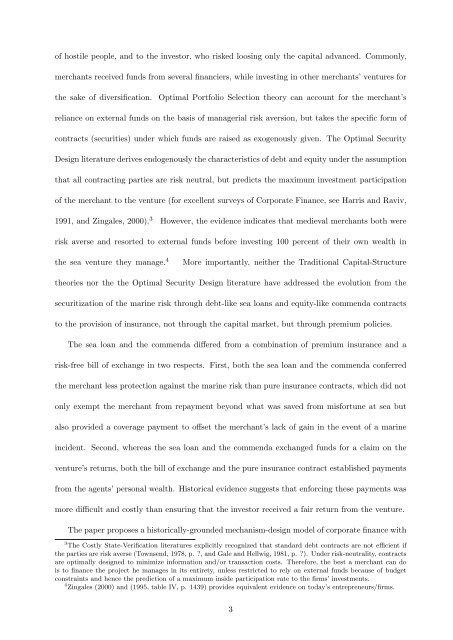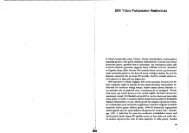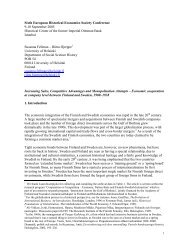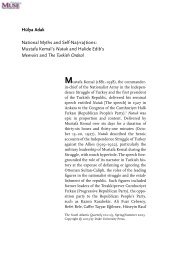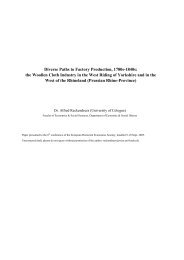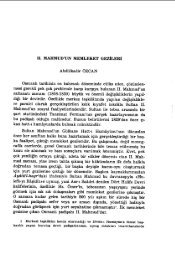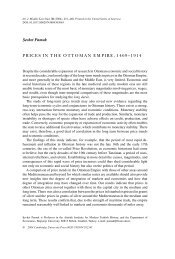The Birth of Insurance Contracts - The Ataturk Institute for Modern ...
The Birth of Insurance Contracts - The Ataturk Institute for Modern ...
The Birth of Insurance Contracts - The Ataturk Institute for Modern ...
Create successful ePaper yourself
Turn your PDF publications into a flip-book with our unique Google optimized e-Paper software.
<strong>of</strong> hostile people, and to the investor, who risked loosing only the capital advanced. Commonly,<br />
merchants received funds from several financiers, while investing in other merchants’ ventures <strong>for</strong><br />
the sake <strong>of</strong> diversification. Optimal Portfolio Selection theory can account <strong>for</strong> the merchant’s<br />
reliance on external funds on the basis <strong>of</strong> managerial risk aversion, but takes the specific <strong>for</strong>m <strong>of</strong><br />
contracts (securities) under which funds are raised as exogenously given. <strong>The</strong> Optimal Security<br />
Design literature derives endogenously the characteristics <strong>of</strong> debt and equity under the assumption<br />
that all contracting parties are risk neutral, but predicts the maximum investment participation<br />
<strong>of</strong> the merchant to the venture (<strong>for</strong> excellent surveys <strong>of</strong> Corporate Finance, see Harris and Raviv,<br />
1991, and Zingales, 2000). 3 However, the evidence indicates that medieval merchants both were<br />
risk averse and resorted to external funds be<strong>for</strong>e investing 100 percent <strong>of</strong> their own wealth in<br />
the sea venture they manage. 4 More importantly, neither the Traditional Capital-Structure<br />
theories nor the the Optimal Security Design literature have addressed the evolution from the<br />
securitization <strong>of</strong> the marine risk through debt-like sea loans and equity-like commenda contracts<br />
to the provision <strong>of</strong> insurance, not through the capital market, but through premium policies.<br />
<strong>The</strong> sea loan and the commenda differed from a combination <strong>of</strong> premium insurance and a<br />
risk-free bill <strong>of</strong> exchange in two respects. First, both the sea loan and the commenda conferred<br />
the merchant less protection against the marine risk than pure insurance contracts, which did not<br />
only exempt the merchant from repayment beyond what was saved from mis<strong>for</strong>tune at sea but<br />
also provided a coverage payment to <strong>of</strong>fset the merchant’s lack <strong>of</strong> gain in the event <strong>of</strong> a marine<br />
incident. Second, whereas the sea loan and the commenda exchanged funds <strong>for</strong> a claim on the<br />
venture’s returns, both the bill <strong>of</strong> exchange and the pure insurance contract established payments<br />
from the agents’ personal wealth. Historical evidence suggests that en<strong>for</strong>cing these payments was<br />
more difficult and costly than ensuring that the investor received a fair return from the venture.<br />
<strong>The</strong> paper proposes a historically-grounded mechanism-design model <strong>of</strong> corporate finance with<br />
3 <strong>The</strong> Costly State-Verification literatures explicitly recognized that standard debt contracts are not efficient if<br />
the parties are risk averse (Townsend, 1978, p. ?, and Gale and Hellwig, 1981, p. ?). Under risk-neutrality, contracts<br />
are optimally designed to minimize in<strong>for</strong>mation and/or transaction costs. <strong>The</strong>re<strong>for</strong>e, the best a merchant can do<br />
is to finance the project he manages in its entirety, unless restricted to rely on external funds because <strong>of</strong> budget<br />
constraints and hence the prediction <strong>of</strong> a maximum inside participation rate to the firms’ investments.<br />
4 Zingales (2000) and (1995, table IV, p. 1439) provides equivalent evidence on today’s entrepreneurs/firms.<br />
3


